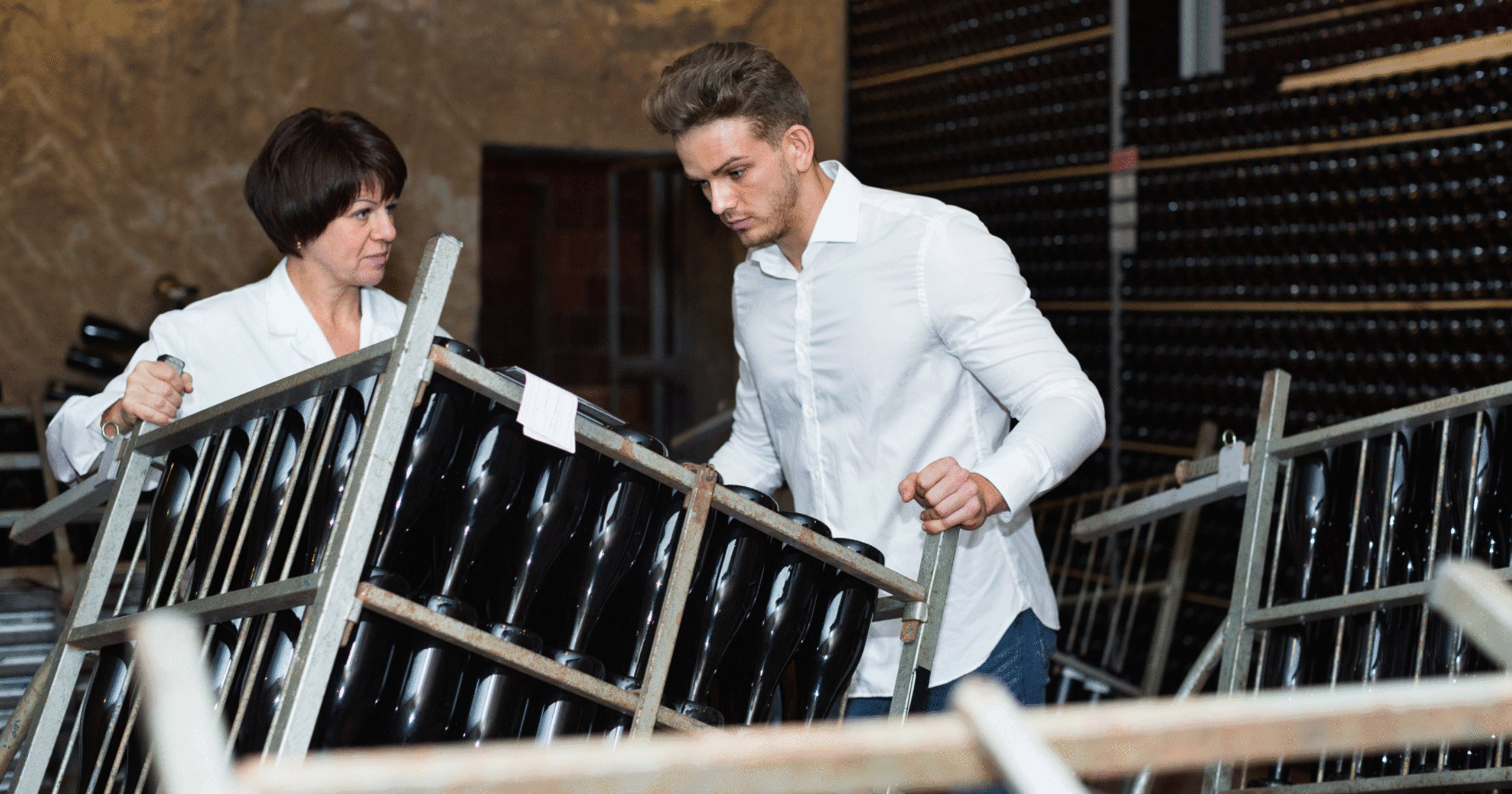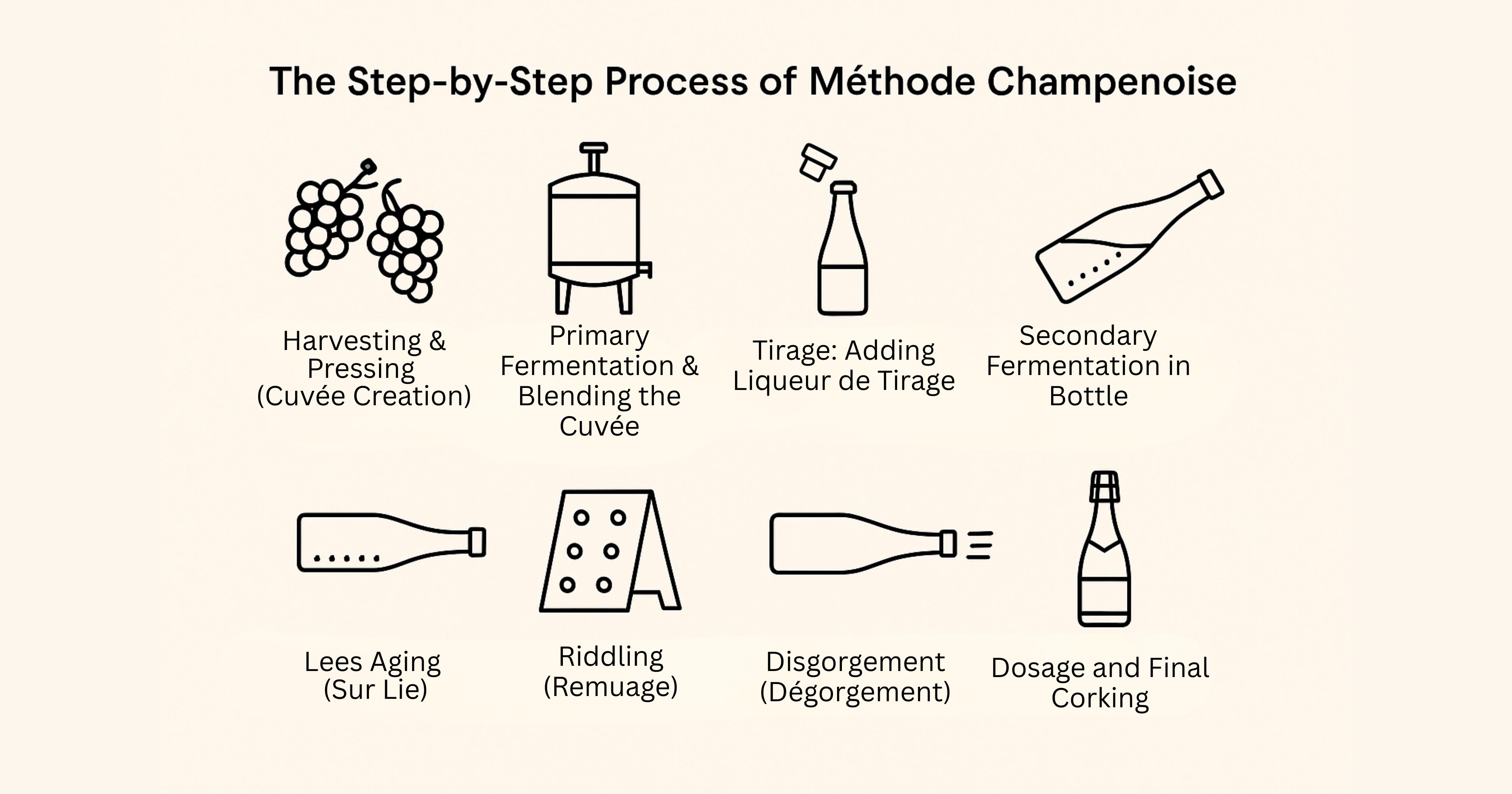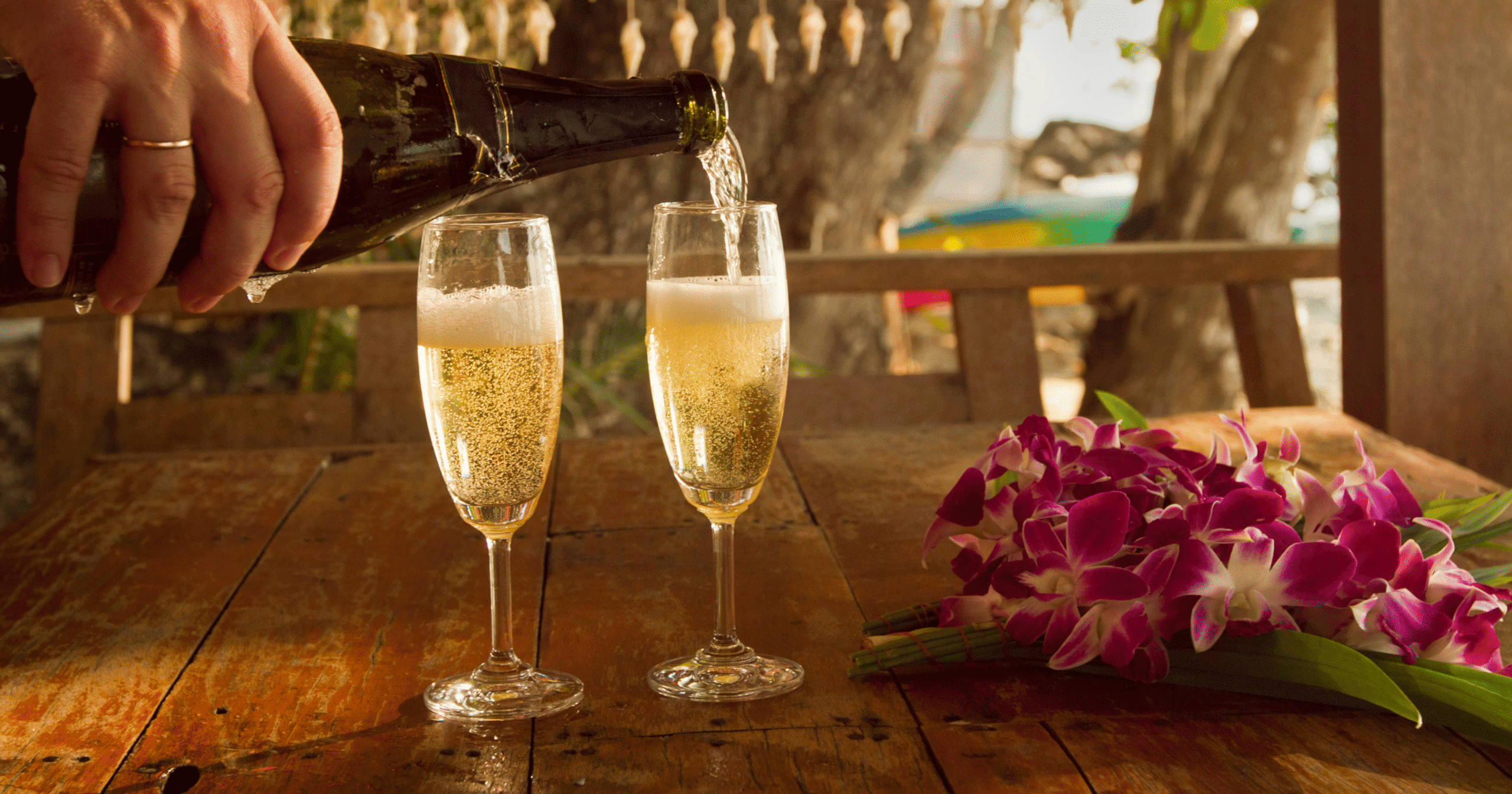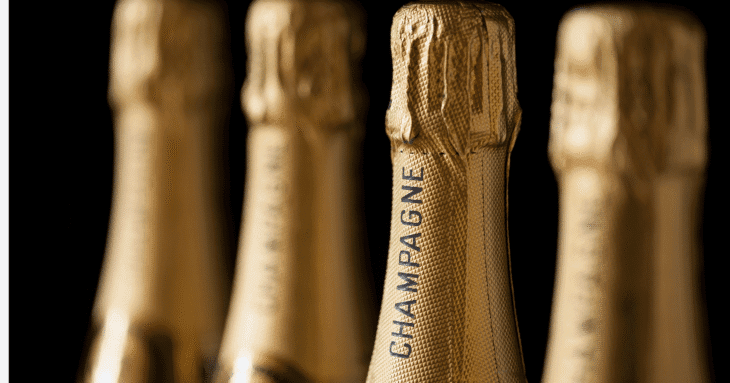The Méthode Champenoise Explained
Sparkling wine has always carried with it a sense of magic, the pop of the cork, the rise of elegant bubbles, the aroma that whispers of celebration and time. But few realize just how intricate and storied the process is that gives Champagne and other traditional-method wines their timeless character. The Méthode Champenoise, also called the traditional method, is more than winemaking; it is heritage, craft, and the embodiment of elegance in every glass.
Key Takeaways
- Méthode Champenoise uses bottle fermentation to create fine, persistent bubbles that elevate sparkling wine’s texture and feel.
- Extended lees aging in Méthode Champenoise adds layers of flavor, from brioche and nuts to honey and spice.
- Sparkling wines made by the traditional method showcase craftsmanship rooted in heritage and generations of expertise.
- Méthode Champenoise wines offer longevity, developing greater complexity and value as they age in the cellar.
- Consumers trust traditional-method sparkling wines because they symbolize quality, prestige, and celebration worldwide.
What Is the Méthode Champenoise (Traditional Method)?

The Méthode Champenoise refers to a winemaking process where the secondary fermentation takes place inside the bottle itself. This is the defining feature that sets it apart from faster, less nuanced methods. Outside of Champagne, winemakers may use the term “méthode traditionnelle,” “método tradizionale,” or “Cap Classique,” since EU law protects the exclusive use of “Méthode Champenoise” to wines originating from Champagne, France. While the terminology may shift depending on the region, the underlying philosophy remains: patience, precision, and profound respect for craft.
The Step-by-Step Process of Méthode Champenoise

1. Harvesting & Pressing (Cuvée Creation)
It begins in the vineyard, where grapes are often hand-harvested to preserve their delicate skins. A gentle pressing extracts juice with minimal tannins, ensuring purity. This first juice, called the cuvée, is the foundation of elegance. Great winemakers know the smallest decisions at this stage shape the entire journey ahead.
2. Primary Fermentation & Blending the Cuvée
The freshly pressed juice undergoes its first fermentation, transforming sugar into alcohol and creating a still base wine. This wine is intentionally high in acidity, sharp and lean, but it is the perfect canvas for the artistry of blending. Here, wines from multiple vineyards, varietals, or vintages may be harmonized. In Champagne, blending is a revered tradition that ensures a consistent house style.
3. Tirage: Adding Liqueur de Tirage
The base wine is bottled with a mixture of sugar, yeast, and nutrients known as the liqueur de tirage. This carefully measured addition ignites the second fermentation within the sealed bottle. A crown cap seals the vessel, locking in carbon dioxide and beginning the slow miracle of sparkling wine’s birth.
4. Secondary Fermentation in Bottle
As the yeast consumes sugar, alcohol rises slightly, but more importantly, carbon dioxide becomes trapped. Pressure builds to nearly six atmospheres, three times the pressure of a car tire, creating the refined effervescence that defines Champagne. The wine now rests, evolving quietly in its bottle.
5. Lees Aging (Sur Lie)
Patience defines this stage. The wine ages on its lees, the spent yeast cells, which slowly break down and release compounds that enrich flavor and texture. Non-vintage Champagne must age for at least 15 months; vintage, at least three years. Many producers extend this period, knowing that extra time deepens complexity, layering notes of brioche, toasted nuts, and cream.
6. Riddling (Remuage)
At the end of aging, bottles are riddled: gently rotated and tilted over weeks until the lees collect in the neck. Traditionally, this was done by hand, a painstaking labor of love. Today, many employ gyropalettes, automated cages that mimic the same process, balancing efficiency with tradition.
7. Disgorgement (Dégorgement)
Once the sediment rests in the neck, the bottle is frozen at the tip. The crown cap is removed, and pressure expels the frozen plug, leaving behind brilliantly clear wine. It is a moment of transformation, removing the traces of fermentation while preserving the life within.
8. Dosage and Final Corking
The final touch is dosage: a measured blend of wine and sugar syrup, known as the liqueur d’expédition. The amount determines sweetness levels, from the bone-dry Brut Nature to the dessert-ready Doux. A cork and wire cage complete the bottle, sealing in years of craftsmanship.
Benefits of the Méthode Champenoise
Superior Bubble Quality
Bottle fermentation produces bubbles so fine and persistent they feel like silk across the palate. These bubbles rise in endless streams, creating a visual performance that hints at refinement before the first sip. The mousse lingers longer than in other sparkling wines, leaving the palate refreshed and elevated.
Greater Depth & Complexity
Extended lees contact develops layers of flavor rarely achievable by quicker methods; notes of toasted brioche, almond, and honey emerge as hallmarks of refinement. Over time, these flavors evolve into subtler hints of mushroom and spice, adding further intrigue. Each glass becomes a journey through stages of maturation that reward patient appreciation.
Prestige & Craftsmanship
The traditional method carries a legacy of luxury. Each bottle is a story of generations perfecting their art, a testament to discipline and dedication. From manual riddling to meticulous blending, the craftsmanship reflects a cultural heritage that values excellence over shortcuts.
Longevity & Cellar Potential
Wines made through Méthode Champenoise mature gracefully. Their structure allows them to evolve for decades, rewarding collectors and enthusiasts alike. Over time, acidity softens and complexity deepens, turning a celebratory drink into a collectible treasure.
Consumer Confidence
Globally, the association with Champagne and other traditional-method wines ensures trust. Consumers know they are choosing craftsmanship over convenience. This trust builds loyalty, making Méthode Champenoise sparkling wines symbols of both quality and celebration.
Differences Between Sparkling Wine Production Methods
| Method | Fermentation Location | Flavor Profile | Bubble Quality |
| Méthode Champenoise | In-bottle | Complex, layered, brioche, nutty | Fine, persistent |
| Charmat (Tank) | Large pressurized tanks | Fresh, fruity, floral | Larger, short-lived |
| Ancestral (Pét-Nat) | Bottle (unfinished first fermentation) | Rustic, funky, cloudy | Variable, unpredictable |
| Transfer | Bottle then tank | Balanced, moderate complexity | Good but less refined |
| Carbonation | External CO₂ injection | Simple, straightforward | Coarse, quick fade |
Méthode Champenoise vs Charmat (Tank) Method
The Charmat method, used in Prosecco, ferments wine in large tanks, yielding fruity, approachable wines at lower cost. The traditional method, by contrast, creates more intricate textures and deeper flavors, often at a higher price point.
Traditional Method vs Ancestral (Pét-Nat)
The ancestral method, or pétillant naturel, is rustic and spontaneous; fermentation finishes in the bottle without disgorgement, leaving wines cloudy and unpredictable. The traditional method offers control, refinement, and clarity.
Transfer Method
A hybrid of bottle and tank processes, it preserves some authenticity of bottle fermentation while allowing batch efficiency. While effective, it lacks the romance of disgorgement.
Carbonation Method
The simplest technique, carbonation injects CO₂ directly into wine, much like soda. Fast and inexpensive, it cannot replicate the delicate finesse of bottle fermentation.
Taste, Texture, and Price Comparisons
A clear way to distinguish methods is to compare: Tank-fermented wines offer freshness and affordability; ancestral wines bring adventurous funk; carbonation provides cheap sparkle. Only the traditional method promises refinement, depth, and longevity in one glass.
Why Méthode Champenoise Produces Superior Sparkling Wine

Delicate Bubbles & Texture
The mousse is the heart of the experience. Fine, persistent bubbles enhance not just appearance, but mouthfeel, lifting aromas and caressing the palate. Their presence transforms each sip into something vibrant and alive, a sensory detail that distinguishes traditional-method wines from all others.
Complexity and Depth of Flavor
Time on lees adds dimension impossible to fake. Notes of mushroom, umami, and patisserie emerge, woven seamlessly with fruit and minerality. These flavors develop layer upon layer, ensuring that every glass reveals new subtleties as it opens.
Tradition & Exclusivity
The traditional method carries centuries of heritage. Champagne remains the crown jewel, but every winemaker who employs it pays homage to an enduring craft. By honoring this tradition, they contribute to a lineage that marries artistry with history, reinforcing the exclusivity of each bottle.
Global Variations & Terminology
Champagne (France)
Champagne’s AOC laws dictate strict rules; permitted grapes include Chardonnay, Pinot Noir, and Pinot Meunier. Non-vintage bottlings require at least 15 months of aging, while vintage demands three years or more. Prestige cuvées often rest for much longer.
Crémant, Cava, Franciacorta, Espumante, Cap Classique
Across Europe and beyond, regions adopt the traditional method with pride. France’s Crémant, Spain’s Cava, Italy’s Franciacorta, Portugal’s Espumante, and South Africa’s Cap Classique all demonstrate how terroir shapes sparkling wine in unique ways.
New World Sparkling Wines
From California to Tasmania, winemakers embrace the method with passion. In cooler climates, New World producers rival the Old World in precision, offering fresh interpretations of age-old traditions.
Celebrating the Legacy of Méthode Champenoise
The Méthode Champenoise is not simply a process; it is the poetry of patience, precision, and passion. Each stage, from harvest to cork, builds a narrative of craft that culminates in celebration. To understand it is to deepen one’s appreciation of sparkling wine, to see beyond the bubbles into a lineage of artistry.
We encourage every enthusiast to explore, taste a Crémant beside a Champagne, compare a Franciacorta to a Cap Classique, and notice how each bottle tells both a regional and universal story. And when the moment calls for something extraordinary, we invite you to celebrate with us. At California Champagne Sabers, our passion is honoring this tradition with tools that make every opening as timeless as the wine itself.
